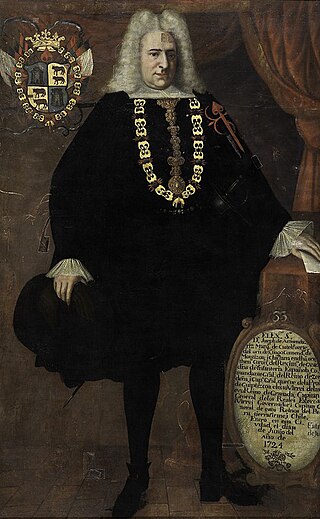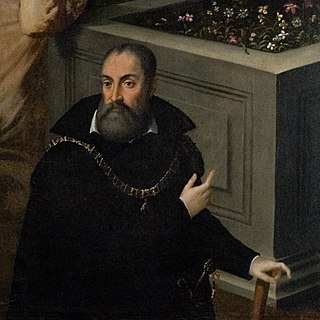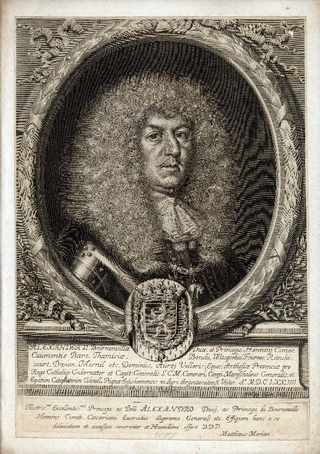
Francesco Maria Carafa (died 1642) was an Italian nobleman, 5th Duke of Nochera, [1] a Knight of the Order of the Golden Fleece and was viceroy of Aragon and Navarre and a military commander who commanded troops loyal to King Philip IV of Spain.

Francesco Maria Carafa (died 1642) was an Italian nobleman, 5th Duke of Nochera, [1] a Knight of the Order of the Golden Fleece and was viceroy of Aragon and Navarre and a military commander who commanded troops loyal to King Philip IV of Spain.
Carafa married Anna Pignatelli, Marquess of Belmonte and later Giovanna Ruffo. In 1610, he rearranged his land holdings, selling the comune of Tiriolo to the Duke of Messina. [2]
In 1625 he took part in the Siege of Breda and then transferred into the ranks of the Neapolitan cavalry in Lombardy, where five years later he was appointed Master of the Field in the region near Piedmont and Monferrato.
In 1633 his commanded troops during the Battle of Nördlingen against the Swedish Empire and secured a decisive victory for Spain. He then went to Flanders in support of Cardinal-Infante Ferdinand of Austria until he was recalled by Philip IV and appointed Commander General in Guipúzcoa to take part in the (failed) plan to invade France.
In 1639, Carafa was named viceroy and Captain General of Aragon and was named a Knight of the Order of the Golden Fleece. The following year he was named viceroy and Captain General of adjoining Navarre.
During 1641, Carafa questioned the domestic policies of Gaspar de Guzmán, Count-Duke of Olivares, especially in relation to the Catalan Revolt, and was imprisoned. He died in prison the following year. He was eventually exonerated by a posthumous trial.
Each year in May, the citizens of Nocera gather in costume to watch actors playing Carafa and his bride come together in ceremonial marriage. [3]

Fernando Álvarez de Toledo y Pimentel, 3rd Duke of Alba, known as the Grand Duke of Alba in Spain and Portugal and as the Iron Duke in the Netherlands, was a Spanish noble, general and diplomat. Alba achieved notoriety for his actions during the Eighty Years' War in the Spanish Netherlands, where his prolonged military campaigns and harsh repression failed to suppress the Dutch Revolt.

Marcantonio II Colonna, Duke of Tagliacozzo and Duke and Prince of Paliano, was a Roman aristocrat who served as Viceroy of Sicily in the service of the Spanish Crown, general of the Spanish forces, and Captain General of the Church. He is best remembered for his part as the admiral of the Papal fleet in the Battle of Lepanto. He was "one of the most illustrious land and sea captains of the 16th century".

José de Armendáriz y Perurena, 1st Marquis of Castelfuerte was a Spanish soldier and colonial administrator. From May 14, 1724 to February 4, 1736 he was viceroy of Peru.

Juan Manuel Fernández Pacheco y Zúñiga, Duke of Escalona and Marquess of Villena, was a Spanish aristocrat, politician, and academician who founded the Royal Spanish Academy.

Duke of Medinaceli is an hereditary title in the peerage of Spain, accompanied by the dignity of Grandee. The Catholic Monarchs, Ferdinand II of Aragon and Isabella I of Castile, created the title and awarded it on 31 October 1479 to Luis de la Cerda y de la Vega. He also held the title of 5th Count of Medinaceli, which was first awarded in 1368 to his ancestor, Bernal de Foix.

Ferrante I Gonzaga was an Italian condottiero, a member of the House of Gonzaga and the founder of the branch of the Gonzaga of Guastalla.

Claude Lamoral, 3rd Prince of Ligne, Prince of Epinoy, Marquis of Roubaix and Count of Fauquemberg, was a nobleman from the Spanish Netherlands, a soldier and diplomat in the service of Philip IV of Spain and Charles II of Spain.
Jean François de Bette, 3rd Marquess of Lede was a Belgian military commander in Spanish service. He was also lord of the Fiefdom of Lede in Flanders.
Beltrán de la Cueva y Toledo, 3rd Duke of Alburquerque,, was a Spanish nobleman and military leader.

Alexander von Bournonville, Alexander de Bournonville, Alexander II Hyppolite, Prince of Bournonville and third Count of Hénin-Liétard was a Flemish military commander. He held the titles of Field Marshal of the Holy Roman Empire, Knight of the Order of the Golden Fleece, Viceroy of Catalonia (1678–1685) and Viceroy of Navarre (1686–1691).
Juan Manuel Pérez de Guzmán y Silva was a Spanish noble and 8th Duke of Medina Sidonia.

Francesco Caetani, 8th Duke of Sermoneta, was an Italian nobleman in the service of the King of Spain.

Francisco V Fernández de la Cueva y Fernández de la Cueva, was the 10th Duke of Alburquerque, a Grandee of Spain, a Knight of the Order of the Golden Fleece from 1707, and Viceroy of New Spain from 27 November 1702 to 14 January 1711. He was viceroy during the War of Spanish Succession and his tenure as Viceroy of New Spain is commemorated in the namesake of Albuquerque, New Mexico.

Gonzalo II Fernández de Córdoba, third Duke of Sessa, was the grandson of a Viceroy of Naples, Gonzalo Fernández de Córdoba, first duke of Sessa, the son of the first duke's daughter, Elvira Fernández de Córdoba y Manrique, and of her husband, Luis Fernández de Córdoba. Gonzalo II, holder of several dukedoms and many other lesser titles, Spanish and Italian, was Captain General of the Spanish Troops in Italy, Great Admiral of the Kingdom of Naples, and a member of the Spanish king Royal Council for Italy and the Royal War Council.

Luis Guillermo de Moncada y de Aragon y de la Cerda y de la Cueva was a Spanish nobleman and Roman Catholic cardinal. He was a Knight of the Military Order of Alcantara in 1630, Viceroy of Sicily 1635 -1639, Captain General and Viceroy of Sardinia (1644), Viceroy of Valencia in 1652 and a Knight of the Order of the Golden Fleece in 1651.

The House of Carafa or Caraffa is the name of an old and influential Neapolitan aristocratic family of Italian nobles, clergy, and men of arts, known from the 12th century.
Antonio Manrique de Lara, 2nd Duke of Nájera was a Spanish noble and military leader, and Viceroy of Navarre between 1516 and 1521.

The House of Zúñiga is a Spanish noble lineage who took their name from their domain. Various members of the family were distinguished in the service of the Spanish crown in Europe and the Americas as viceroys, governors, military, diplomats, writers and members of religious orders. Charles I of Spain in 1530 named two members of the family, the Duke of Béjar and Plasencia and the Count of Miranda del Castañar, among his Immemorial Grandees, while eight members of the family were inducted into the Order of the Golden Fleece.

Girolamo Carafa, Marquis of Montenegro was a general in Spanish and Imperial service from Italian descent.

Duke of Nochera is a hereditary title in the Peerage of Spain, accompanied by the dignity of Grandee. Originally styled "Duca di Nocera", it was granted in 1656 by Philip IV to Francisco de Moura Corterreal, Viceroy of Sardinia and Catalonia and governor of the Spanish Netherlands. The title made reference to the town of Nocera dei Pagani, in the Kingdom of Naples, subjected to Spain at the time.